*** DISCLAIMER ***
I receive no reward, monetary compensation nor any benefit from either Volunteer Encounter program or anyone I mentioned in this website and/or article. I post these stories and people only because one time or another they enriched my life experience, refined my knowledge and I appreciate them.
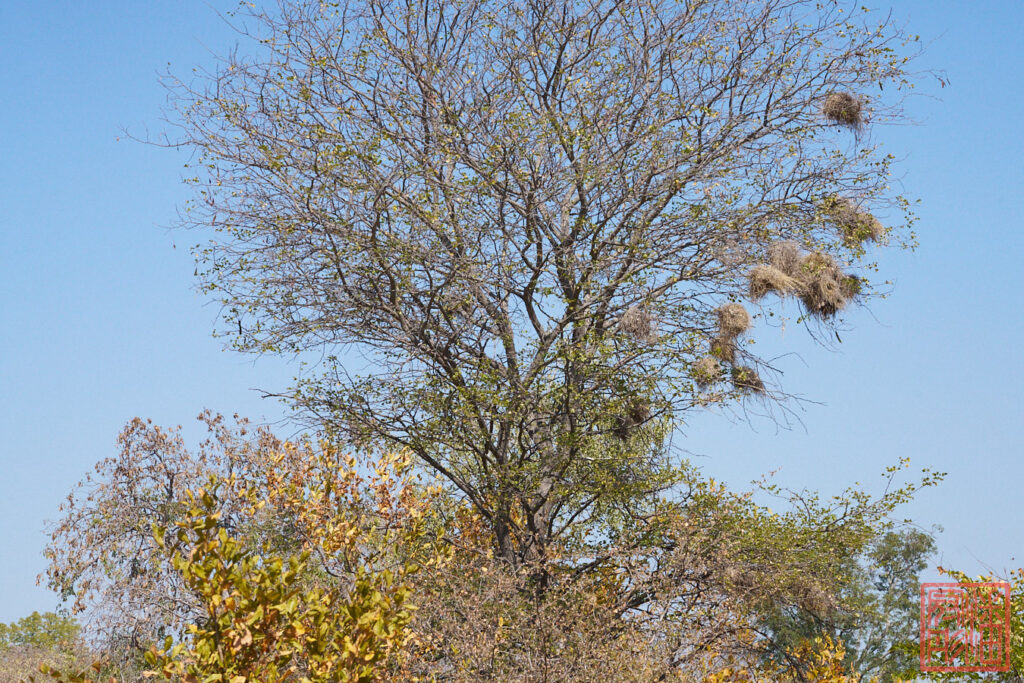
A sense of direction on the Africa Savannah
As a city dweller, Africa savannah are mysterious, fascinating, intoxicating and not mention incorporate with a pinch of danger which needless to say induces excitement. However, local residents have their own wisdom to survive in this vast and unique terrain. For example, we could see a very common phenomenon on the savannah: bird nests built and resided on only one side of a tree but never on both sides. Moreover, it is always the west side of the tree has the nests and never on the east side. The reason is the east side of a tree is in the harm’s way. Strong winds, storm, typhoon, and hurricane are always coming from the Indian Ocean which is on the east side of Africa continent. Animals are no fools and they know where is the safe or safer spot to build their homes. By building their nests on the west side of a tree, not only avoid the direct hit from the typhoon or hurricane but using the east side of a tree to shielding them from it. Armed with this knowledge in mind, you could try to find your ways in the vast and boundless savannah because it gives you a sense of direction if you ever get lost.
A sense of direction on the Africa Savannah II
Another way to get a sense of direction is from ant termites. What a surprise! This may not always work but occasionally you would see a tall but bent ant termite pointing toward one direction. Make no mistake, the bending direction is always pointing toward the west and never east nor other directions. I don’t have a good picture to show it here, my apology, but you may ask any local residents and it’s a common knowledge. The reason is because ants are building their home, termite, during the night and when building their home they would moisturize it. So, the newly build layer of termite is dampish through the night. When the morning comes, the sun rising from the east and the sun ray starting to bake the termite on the east side. This makes the east side of the termite to dry faster than the west side and subsequently making the entire termite bending or tilting toward the west. If you ever get lost on the Africa savannah, don’t forget these two tricks to get a sense of directions. But, let’s just try our best not to let this happen in real life scenario for our own good.
The picture shows a termite but is not bent because it isn’t or the angle isn’t right.
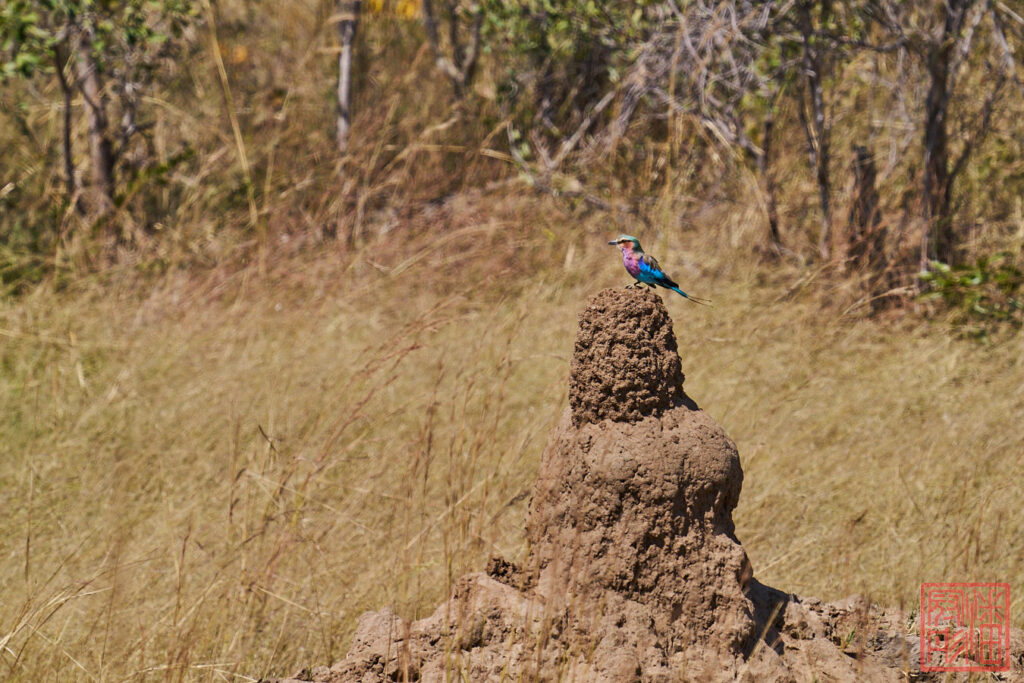
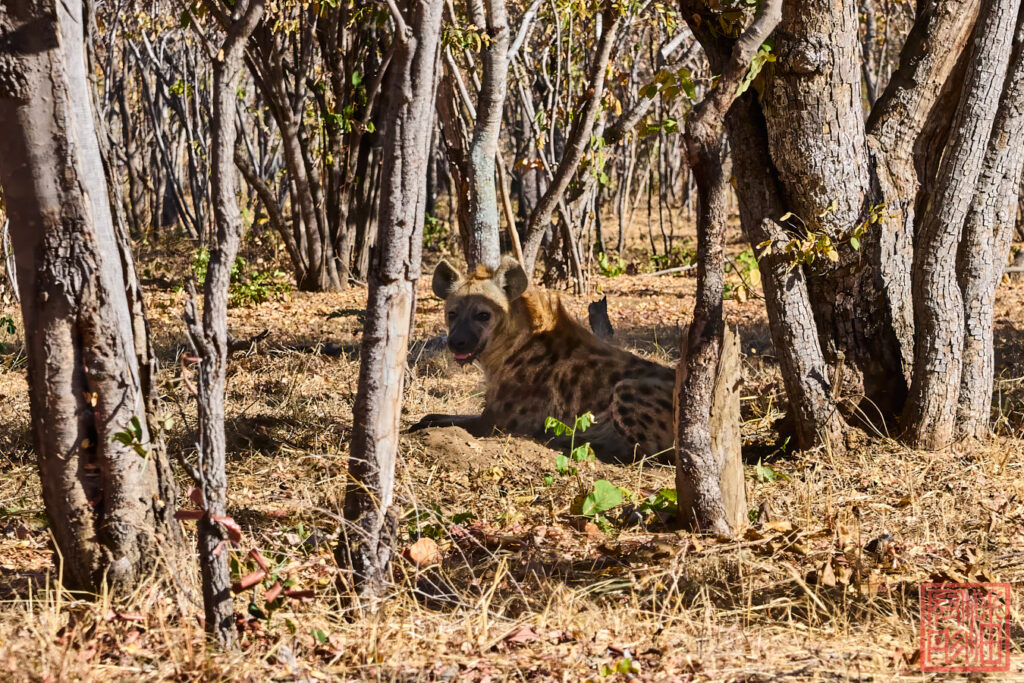
Keep it cool
This is how a hyena keeping itself cool in a hot Africa afternoon; choose a shady area, dig a hole on the ground and lay in there. However, before it lays itself into the hole, it would pee into it first. The reason is to further cooling it down before laying into it. Yes, the hyena you see in this picture is the hyena I am talking about and, right again, it is laying in a hole filled with its own urine when this picture was taken. This may be an useless knowledge or too much information for someone’s taste 🤣 but I personally found it’s fascinating and interesting to witness it and learn.🤩 This is the wisdom of wild animals that we don’t see it everyday.
A male Lilac-breasted Roller’s sacrifices for its species
This is a Lilac-breasted Roller and more specifically a male Lilac-breasted Roller. How do I know it’s a male? Because there are two very long extended feather at the end of its body. These two very long extended feather only exists during the mating season and for a male Roller to attract female’s attention to mate. Once the matting season is over, the male Roller would bite them off because these long and extended feather are impairing their agility and preventing them from flying freely and swiftly hence much easier to fall into the birds of prey as a victim. Just think how far a male would go to extend its own specie.

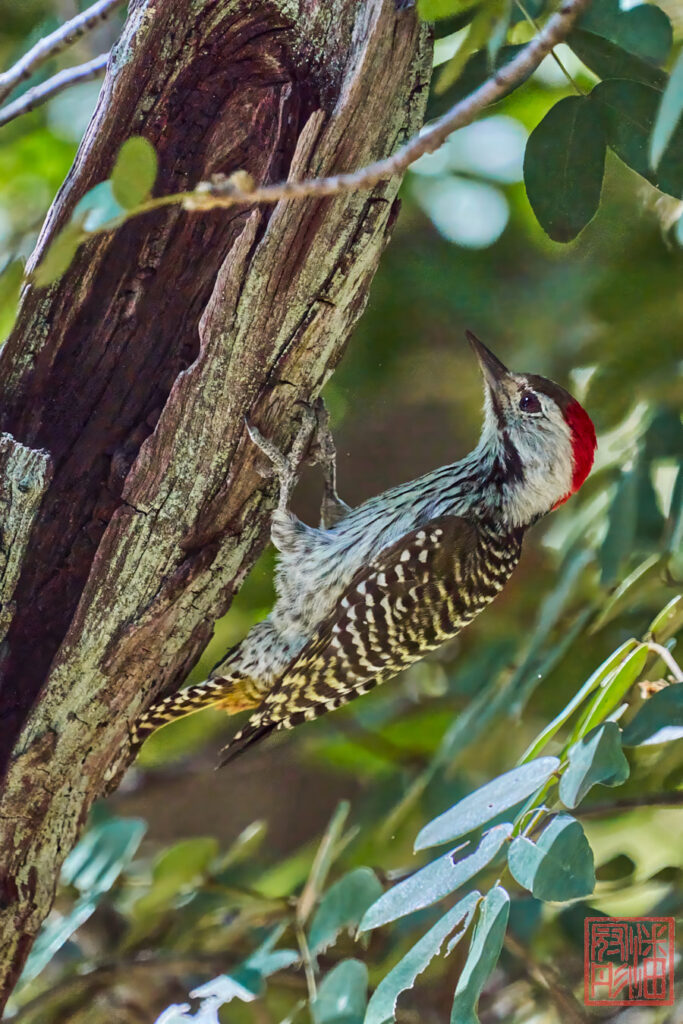
Tiny woodpecker
This is the smallest woodpecker namely Cardinal Woodpecker in Africa and they are roughly 1/3 to 1/2 the size of an adult human palm. It’s extremely difficult to photograph them not only because of its small size but also its swift movement. The fact that they are hunting and hiding under shade doesn’t make things the slightest easier. These images were taken roughly 12:25pm during the noon time with bright daylight but I must crank up the ISO to 1000 just to get a few good enough not even excellent shots.
Welfare for the resident animals
Staff at the Wildlife Encounter camp would hang meats on tree branches and then release the resident lions to let them find a way to get these meat. Believe me, this absolutely doesn’t sound as easy as it is. This has multi-purposes. One is to stimulate the senses of these resident lions. As we all know that these lions live in enclosed area and don’t get much of a chance to hunt. This may not substitute the hunting itself but at least providing an opportunity for them to use their senses. Second, by letting them climbing the tree branches, it provides them an opportunity to exercise. Just like we need to go to gyms when we stuck in the enclosed office for too long and animals also need their share of exercises.
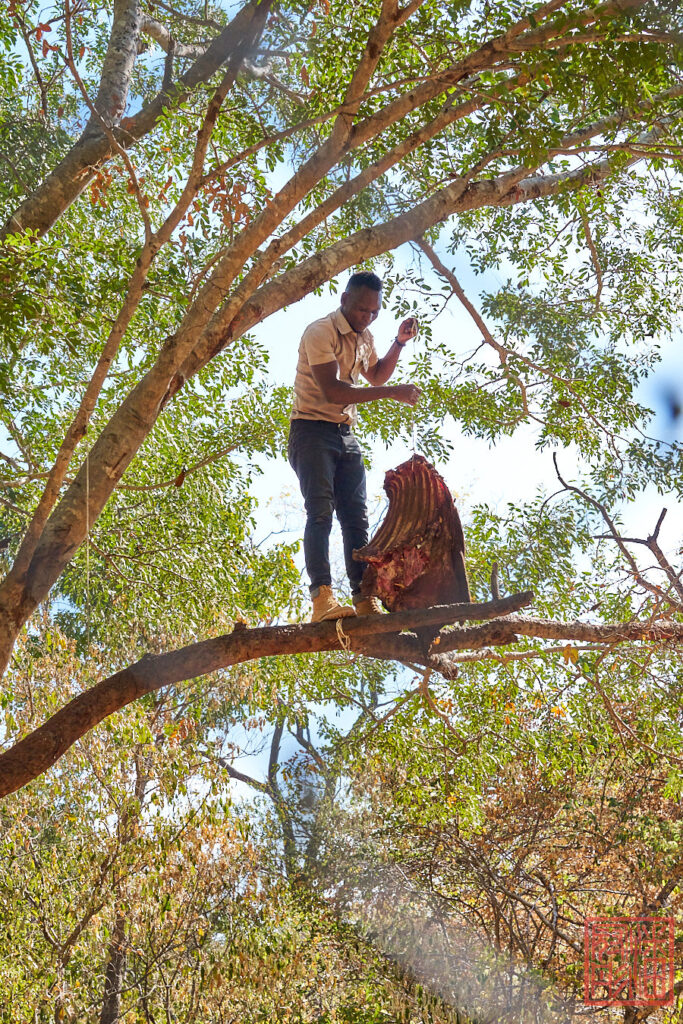
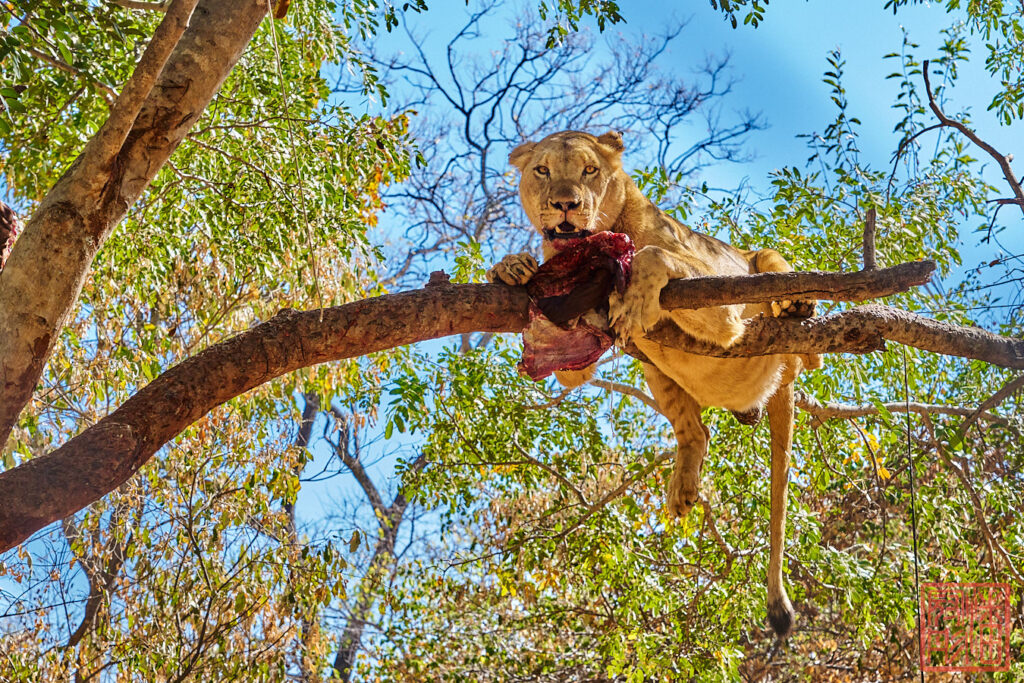
Lioness Rules!!!
Here we could observe a lioness climbed up to the tree branches, grab the hanging meat, find a way to balance and stay on the branches and enjoy her very well deserved juicy steak all by herself. In the mean time, the male lions though much stronger and play a dominating role could only staying under the tree, staring and doing absolutely nothing. You could clearly see that she is showing off her prize. If you look hard enough, you may see the steam coming out from the male lion’s head or nozzle. 🤣
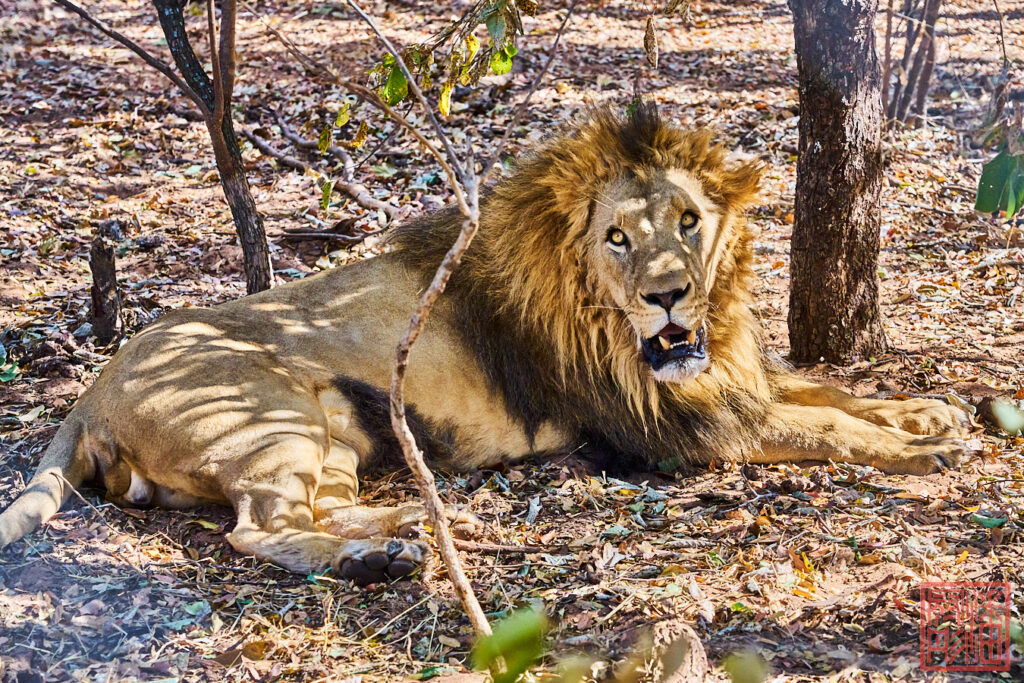
Two Extremes (maybe three)
I wasn’t planned this but it just happened. I was at Canadian Rockies last Fall, merely 7-8 months ago, and taking pictures there. In Canadian Rockies everything was big so big that I must use the 12-24mm lens close to 70% of the time if not more and dial-out at 12mm. Moreover, more often than not I would also slow the shutter down to 0.5 or even 10 seconds to get a good shot on the water flow of a waterfalls or a river. Merely 7-8 months later I am at Zimbabwe and taking pictures of animals. At Zimbabwe I am using the 200-600mm lens with a 1.4x extension to make it up to 840mm and, on top of that, I must dial-in at minimum 1/1600 second to get a good shot of a bird or sometimes even 1/2000 second, a fraction of a second. These are just the two extremes that don’t mix well together and extreme difficult to master either of them. Hum, may be the difficulty to master them is the third extreme. Before I went to these two places, a mid-range such as 24-105mm is my go-to lens and I would say more than 75% pictures were covered by it. The change of situation in the past 6 months definitely gives opportunities for these two extreme lenses a good run for their money. I like it, not only I like to continuously and tirelessly challenge myself but also challenge the equipment I own. Special thanks to my friend Adrian Kalaveshi to help me realize this fact, interesting yet brutal fact.
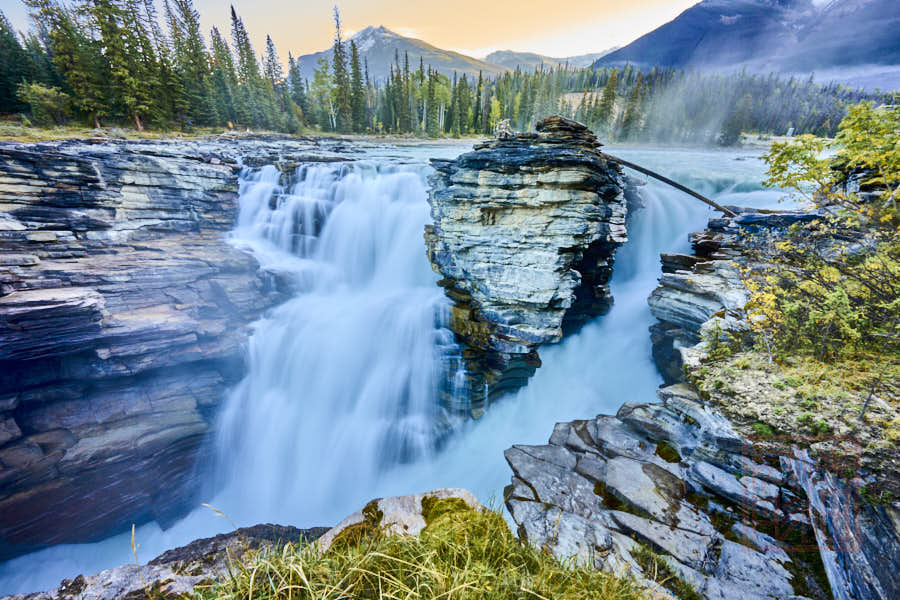
12-24 @ 12mm, ISO 50, 0.5″, F22, Banff NP, Canada
Right:
200-600 + 1.4x @ 840mm, ISO 800, 1/1600″, F11, Zambebi NP, Zimbabwe

The Big Tree
There is a gigantic Baobab tree near downtown Victoria Falls and it’s a historical landmark. It’s named the “Big Tree”. According to local, If you and your friends are gathering together in a Saturday afternoon or any time for a business meeting, you may just tell them “let’s meet at the Big Tree at 1:00pm.” and everyone would know what you are referring to and where it is. This has been a tradition going as far back as anyone could remember. The Big Tree is estimated more than 2,000 years old and very likely the oldest and biggest Baobab tree in the world. It dwarfs everything next to it; yes, indeed, it’s a visual and senses feast by just coming here to admire it.
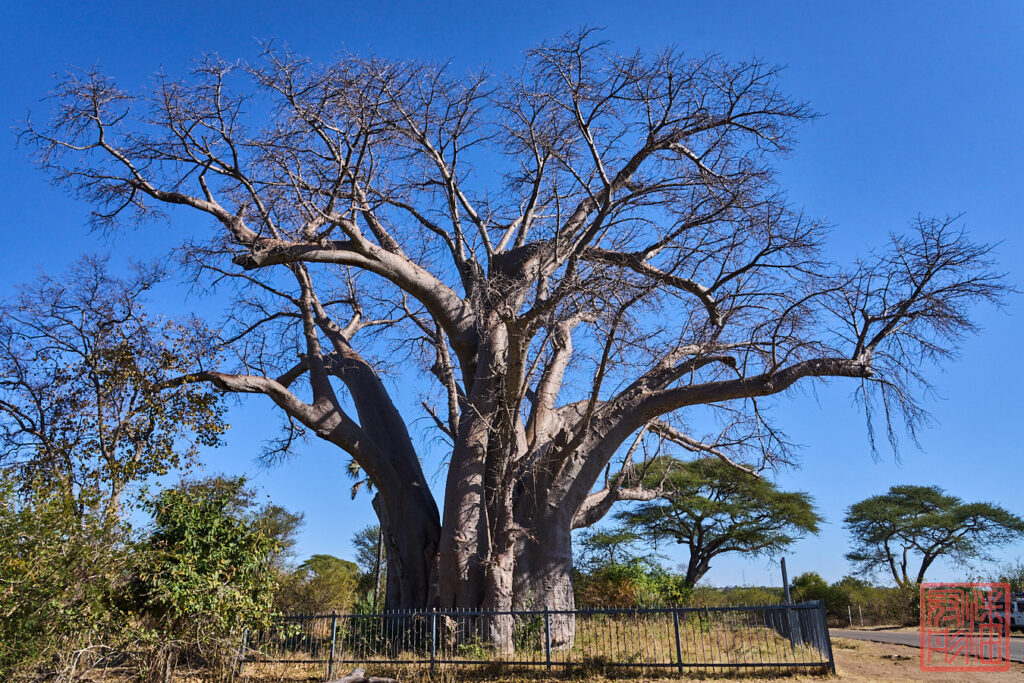
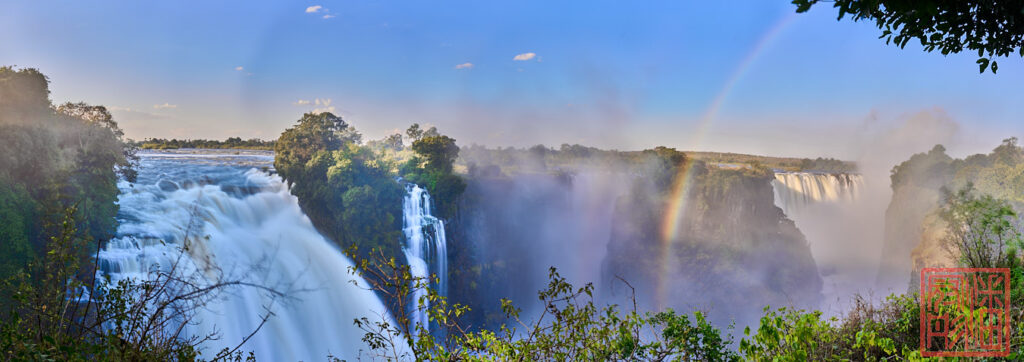
Victoria Falls, Zimbabwe
Victoria Falls. Ah, yes, how could I not talk about Victoria Falls when I had spent about a month near by it? You could see the mist or moisture caused by it miles away, literally miles away. If you don’t know it better, you would easily mistake it as a wild forest fire, seriously. You must shout to each other if you want to talk to the people next to you like you are in a heavy metal concert when you are in its vicinity. If the Big Tree is a feast to your visual sense, then the Victoria Falls is a feast to all your senses; the visual magnificence, the ear drum popping decibel, the mist or rather storm drops pouring on your entire body and the smell of moisture, everything is just mesmerizing and/or intoxicating. Pay a visit, I beg you for your own good as a human being.
Footprints 。 Contrast
This is in the middle of a forest at Chobe National Park, Botswana, and that means this should be an animal kingdom. However, man-made tire-tracks extended anywhere and everywhere. The king of the animal kingdom, the elephant, was sidelined in this image, exactly reflecting and symbolizing the reality. We only see limited footprints from elephants in the image and majority of the image was occupied with tire-prints. The elephant footprints are organic and the tire-prints are mechanic. The tire-prints are bright and featured and the footprints are vague and overlaid. From the multiple tire-prints we could deduce that there were many vehicles drove by and there was one set of foot-prints.
As I mentioned before that contrasts are one of my favorite subjects to be expressed in my art work and this is yet another example. Wild animals are sidelined in their own natural environment, their own kingdom and the future looks dim just like the contrasts symbolized in the previous description. I brought back anywhere between 70 to 80,000 pictures after stayed four weeks in Zimbabwe and one day in Botswana. This is definitely the best image out of the 70 to 80,000 pictures.
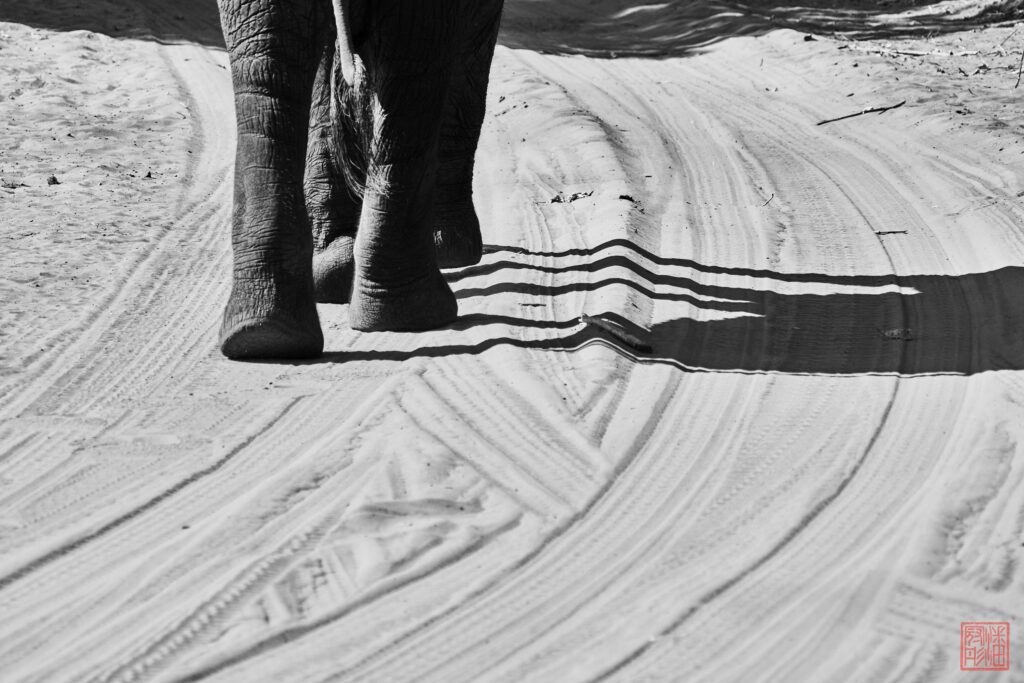
Baboon King
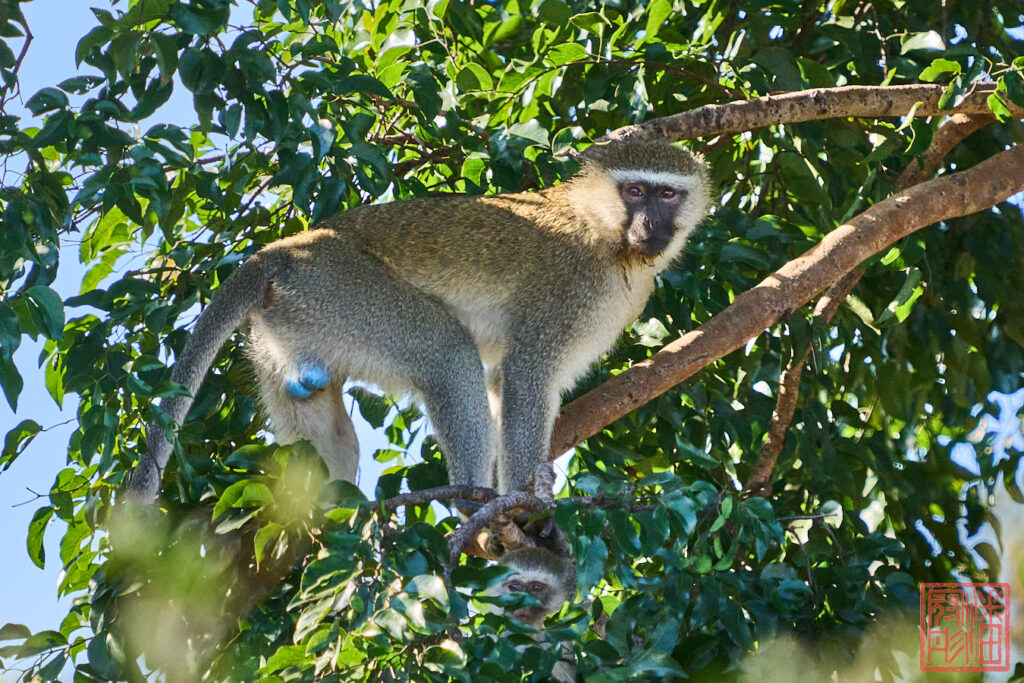
There are a few layers of difficulties while taking wild animals pictures. The first is to find them which by no means an easy task. If it’s that easy to find them, they would be extincted already. The second is to get a good shot of them. By saying good shot, it means in good focus, reasonably stable and beautifully framed. The third is to take a few good shots before they disappear. None of these could be taking lightly and on top of these you may want to finish all three steps in merely a few seconds. Wild animals are no fools and they won’t wait for you, not at all. So, while I was taking shots at this baboon, I was so fixed on the subject and paying no attention on anything else. I was in the zone. However, I could hear our guide/driver Aaron saying things in the background like “This is the baboon king!”, “There is no doubt that this is the king of the group”, “Yes, he is the king”. My eyes were trained on the baboon through the viewfinder, my fingers were tense but lightly rest on the shutter release and function buttons and my attention was fixed on the lightest movement of the baboon body position related to its surrounding to get the best possible framing. After I was finally done and the baboon disappeared into the tree branches and leaves, it finally dawn on me how and why would Aaron be so sure that this is the baboon king? Why can’t I tell? What makes him the king? Right before I opened my mouth to ask, Aaron announced to everyone in the safari vehicle “Have you seen the big and bright blue pair of that baboon? That is why he is the king. Only the king could have such big and bright blue pair in a group of baboons.” I had on idea what he was talking about and immediately invoke the review function of my camera to see the pictures I just took. Only by then I see what Aaron means by “big and bright blue pair”. Yes, this is no doubt the king.
Darting Lions
After two weeks staying at the Volunteer Encounter campsite, I was very lucky to meet with a group of veterinarian came from the US. If I am not wrong, they were at the campsite to observe and learn the lion care. Not only there was a forum held by the prominent conservationist Ian Du Preez to discuss animal cares, but also conducted a real life lion-darting activity lead by the resident veterinarian. 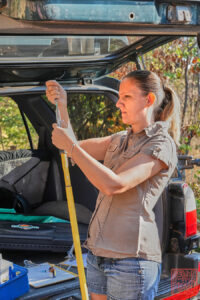
(Resident veterinarian at Volunteer Encounter preparing anesthesia on a dart stick to get ready.)
The Volunteer Encounter resident veterinarian would do a demo in what, how and how much anesthesia to use to dart lions and I was very fortunate to witness and used my camera to document the entire session. It’s a way more delicate activity than I could ever imagine. For example, after the entire process was done and it’s time to wake up the two drugged lionesses, the resident veterinarian would inject a medication into those two lionesses to help them to wake up. But, it’s far from done. Since there were two lionesses under the influence of anesthesia, like human beings, the reaction to these drugs are totally depending on individuals. So, one of the lionesses woke up before the other. During all this time, the resident veterinarian and her assistant kept a respectful distance yet close enough to these two lionesses because even though they know these two lionesses were sisters but there is no guarantee that the one who woke up first wouldn’t attack the other one. I was first confused why would the veterinarian and her assistant need to stay with the lionesses for the extra 20 to 30 minutes? Isn’t it dangerous? We are know that lions are no vegetarians. This is like playing with fire next to a gas pump! Aren’t the resident veterinarian and her assistant making themselves a food target in front of these two awakening and pissed-off lioness? Personally I think it is so fascinating to learn that these staff at the camp are devoting their knowledge, experience and even risk their own safety for these enclosed lions.
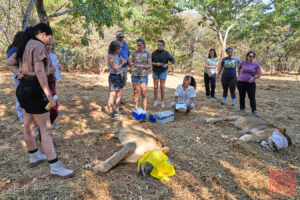
(Right after these two lionesses were darted and moved to a more flat surface to be ready for further inspection.)
Almost right after these two lionesses were injected the drug to help them to wake up, we, as observers, were all asked to leave the lion enclosure and could only observe from a farther distance outside of the metal fence. However, the resident veterinarian and her assistant kept staying in the enclosure with those two lionesses an extra 20 to 30 minutes to make sure both lionesses were fully awake, functioning and safe. In the mean time, all the rest of us could only held our breath standing outside the metal fence and hoping everything would work out as planned.

(The resident veterinarian and a veterinarian from the US are working together to do physical exam on one of the lioness.)
What if the first awake lioness attacking the other one? What if the second lioness doesn’t wake up? What if they become hostile toward the resident veterinarian and her assistant? What kind of action or measurement should we take if any of the above cases happen? Has any incident happened in the past? Like I mentioned before, it’s a very, very delicate operation. This is not like watching it in front of a TV hundreds or thousands miles away because you are right there and experiencing the nerve with them all together. I fully appreciate this opportunity for at least myself to understand the complexity, depth and care involved in this operation. My salute to all the people involved in this operation from Volunteer Encounter campsite.
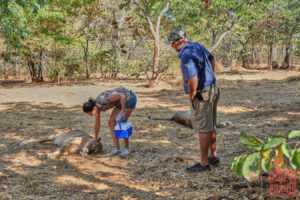
(Resident Veterinarian and her assistant conducting a final check before leaving the darted lionesses.)
P.S. I only mentioned the resident veterinarian and her assistant in the above paragraph but there were at least another 5 – 8 Volunteer Encounter staff, may be more, involved at the scene and they are as essential as anyone there to accomplish this. My salute.
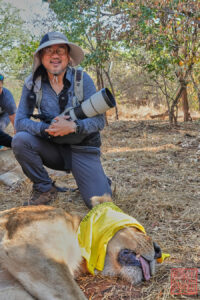
(This is how I would “hunt” a lion, with my camera and lens.)
Our Head Guide/Driver
Everyday at the Volunteer Encounter campsite we have different “classes” through the day to keep us engaged and busy. “Game drive” is a fixed activity happens on every Friday and that means we have to be at the gathering point at around 5:45am, loading up to the game drive vehicle and heading toward the Zambezi National Park in darkness. We won’t come back to our campsite for 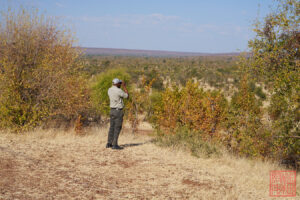
(Aaron is hunting for more animals for us to see in the field.)
dinner till close to 6:00pm, again in darkness, and, yes, it’s an almost 12 hours activity. It’s not just long but rich because you never know what kind of experience you would run into at the national park even though it’s the same Zambezi National Park. Other than the excitement to observe those wild animals, I must use this opportunity to introduce our guide/driver Arron Murambiza here. He is a tall, strong and broad shoulder African and most importantly he knows what he is doing. Because of him, our journey into the national park was more than pleasant. He would choose different routes in the park to find animals for us to observe. He could communicate with other guides/drivers to be informed where the animals were. There was one incident that we saw a herd of African buffalo far away on the other side of a dry river bank. It’s so far away even our high powered long range lens couldn’t reach them well. Arron didn’t say a word but started driving. At first we all thought it’s too far away from us so we were leaving the scene to hunt for other opportunities. Moments later, after quite a few winding and bumping roads, we realized that Arron brought us crossed the dry riverbank and the herd of buffalo right in front of our faces! I could switch to the mid-range lens to capture a few good shots! It’s amazing! Honestly speaking, when the first time we saw those African buffalo, Aaron did his job and that’s was good enough. But good enough wasn’t enough for Aaron, he had to drive us through a series of winding, bumping, and climbing off roads to get to those buffalo so we could do a close-up. Hail Aaron!!!
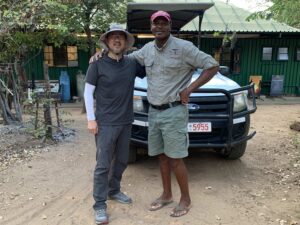
(Aaron and I in front of his game drive 4×4 truck.)
The following is our head guide Aaron Murambiza’s contact information and you may get in contact with him if you ever need his service. He is familiar with Zimbabwe, Botswana, Namibia and South Africa.

Ruthless and Fearless Handsome Mike
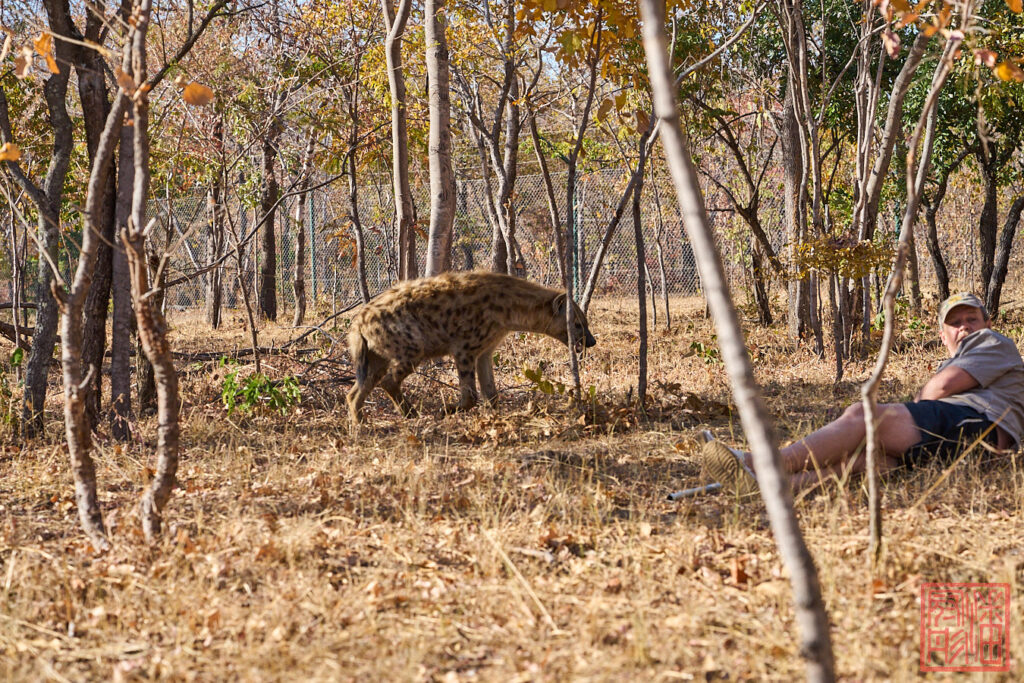
See the guy lying on the ground almost right next to the Hyena? It’s Mike. Why could he be so ruthless or fearless? We see only one hyena in this image but there are another two hyenas in the close vicinity around us while this picture was taken. Though these hyenas are grown up at the Volunteer Encounter camp but they are 100% wild animals and not domesticated at all. Then again, why could Mike be so ruthless or fearless? The fact was these three orphaned hyenas were rescued from wilderness when they were merely puppies and Mike took care of them and saw them growing up. To Mike, they are like his dogs and even somewhat behaving like dogs around him. Mike would call them by their names, yes, Mike named every and each one of them, and gave verbal commands to them. (As of how much would these wild hyenas obey those commands, that’s entirely another story. Sorry, Mike!)
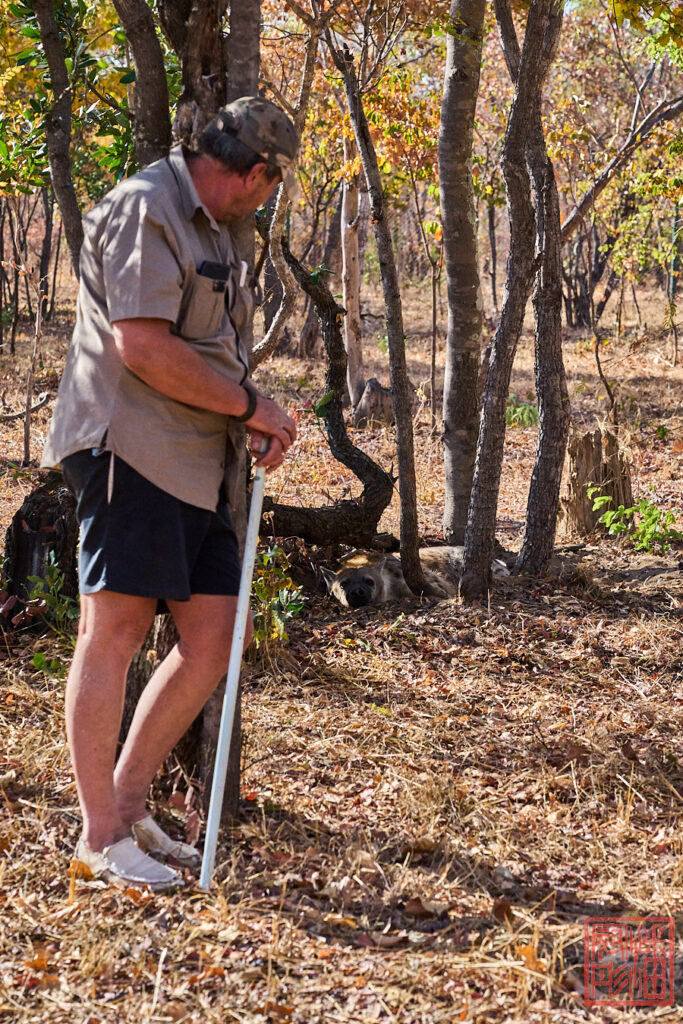
During one visit to the hyena enclosure Mike asked me to take my camera and go forward to take a close-up shot of one of the hyenas. Not to show my chicken inner world in front of other members of the group, I step forward but couldn’t control my trembling legs yet Mike was closer to it than I was. (Mike was closer to it to protect me from the hyena. Remember, these are indeed wild animals.). I have every right to fear. The biting force of a hyena is 1,000 pound per square inch which is equivalent to an adult male lion’s biting force. For those of you who don’t know, it’s bone crushing! Where else could you get this kind of experience in the world? It’s amazing yet trembling!!!
Chorus in the Nights
I bet we have all experienced being awaken in the middle of a night by the air piercing ambulance sirens or ear drum vibrating violently motorcycle engine in a corner of a city or suburban. Nevertheless, has anyone had an experience in having lions’ roaring as lullaby or midnight songs? The deep yet loud roaring were so clear in the pitch dark nights, you would sometimes feel it’s right next to your tent. Sleeping in a tent not far from the 25 lions’ enclosures, it’s a privilege to enjoy this. It would start with one or two lion’s roaring then become a few lions’ roaring and finally a pride of lion’s roaring. It may last less than a minute and went as abruptly as it came. For the first few nights, you would even wonder if by any chance you would be attacked in the middle of the night by any one of these beasts since the roaring sounding so clear and so close. A few nights later, if you don’t hear it for an extended period of time, you would start questioning what’s going on? Is there something wrong? How are those lions? Are they ok? It turns out this is a valid concern. According to the prominent conservationist Ian Du Preez, roaring is a way for lions to communicate. If they stop roaring, then there must be something very wrong and need to be checked out.
For a few nights at the camp, I had chance to be sitting outside the tent I slept in, staring at the stars in the dark sky and enjoying the lions roaring penetrating through the darkness. I wonder what they are trying to communicating with each other. I wonder if these roaring could be understood by other animals and if they could, how would other animals fell about these communications. I know little about these roaring but one of the purposes is calling, calling other lions in the vicinity. Then, I wonder what if any wild lions other than those in the enclosures would hear these roaring and come to check it out. Suddenly, the night wasn’t as peaceful as it seems and I would then tiptoe retreating into my tent facing outside, the borderless and pitch dark African Savannah, even though I know the fact that the canvas thin tent wall would hardly protect me from any lions.
25 Lions
Some maybe curious as why are there 25 lions enclosed at the camp? Where are they from? Why are they in captive? Is this a “volunteer” scam but the real purpose is to attract tourists like us to actually practice commercial cruelty?
For what I understand is that Zimbabwe is short of predator especially the top predator, lions. So, a few years back, a project was brewed and brought 25 lion cubs from neighboring countries. The plan is to grow these 25 lion cubs at the camp and then train them to hunt and survive in the wilderness independently by themselves. Once they learned how to hunt and survive in the wilderness independently by themselves, they would be released into the Africa savannah. This plan not only received the permission from the Zimbabwe government but also received the financial funding and support from it. Unfortunately, not long after the starting of the program, pandemic happened. Zimbabwe is one of the poorest countries in the world and pandemic had just made things worse. Because of pandemic, Zimbabwe government decided to pull out the financial support from the program. At this point, they couldn’t just release these 25 lions into the wilderness. If they do, it’s no different than murder because none of these lions was ready or could be independent. In the mean time, time wouldn’t wait. These 25 lions grew and passed the best time to be trained to hunt and survive by themselves. Now all 25 lions stuck at the camp. They are too old to be trained and too naive to be released into the wilderness. However, this doesn’t mean that they are useless or abandoned. If you had been there, you would observe that all the lions have oily and shiny skin and full of energy which is a sign that they are under excellent feed and care. Moreover, they are subject to be studied by visiting veterinarians like one of the above articles described. Furthermore, camp staff would also study them with different cooking seasoning to see their preference. Once we know their preference, it’s a good warning to anyone who is planning to camping or cooking in the open Africa savannah. On top of this, we have also included common things like sunscreen, bug spray, toothpaste or soap and shampoo. Things tourists would bring into the Africa savannah to camping and issue warning to them to avoid these items. These are the activities that I know of and participated. I believe there are more things that I don’t know because ultimately I had been there for only a short period of one month. Participating this program is also supporting these 25 lions and I am very happy and fortunate being part of it. Like I said before, it doesn’t matter how long I had been there, it’s only a very short period of time but the memory lasting for a lifetime.
Note:
What I described in the above “25 Lions” section is my personal understanding of the program. If there is any mistake or inaccuracy, then that’s my personal responsibility and there is nothing to do with Volunteer Encounter.
*** DISCLAIMER ***
I receive no reward, monetary compensation nor any benefit from either Volunteer Encounter program or anyone I mentioned in this website and/or article. I post these stories and people only because one time or another they enriched my life experience, refined my knowledge and I appreciate them.
